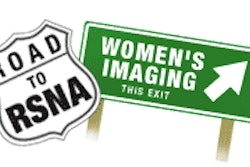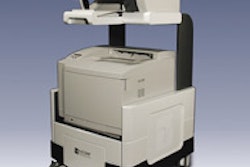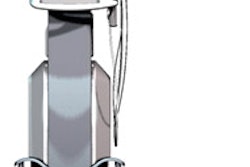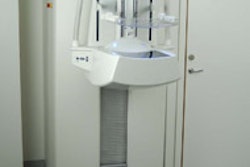Everyone knows it's unwise to put the cart before the horse. But others have just recently learned that the same concept applies to hitching up full-field digital mammography (FFDM) and PACS. As it turns out, putting PACS before FFDM can help ensure a pleasant journey into the digital era, and help familiarize users with the ride.
"It's important, in my opinion, that people don't start off with digital mammography when they do PACS," explained Dr. Michael Trambert from the Sansum - Santa Barbara Medical Foundation Clinic in Santa Barbara, CA. "I'm sure some will back into PACS by first going with digital mammo, but we first went live with our PACS (DR Systems, San Diego) almost seven years ago with our hospital ... and then the Sansum clinic also went live with the same PACS around 2001.... I think that's ideal if you want to have really smooth acceptance of digital mammography on monitors."
Trambert would certainly know best, having steered the FFDM and PACS paradigm at his institution. In a presentation at the 2004 RSNA meeting in Chicago, Trambert, who is the lead radiologist for PACS re-engineering at the clinic, shared the results of his group's experience integrating PACS and digital mammography on a SenoScan system (Fischer Imaging, Denver).
Specifically, the study looked at productivity, image quality, exam, and universal report access over the Web. In a follow-up interview with AuntMinnie.com, Trambert elaborated on the findings and offered helpful hints for others considering the same route.
Trambert is a medical advisor to DR Systems; one of his co-authors, Dr. Hector Rodriguez, is an unpaid advisory board member for Fischer Imaging.
Making the most of FFDM and PACS
The Sansum clinic performs 18,000 mammograms per year. All 180 Sansum physicians, as well 100 community physicians and those at the local Cottage Hospital, have access to the PACS via a Web server, Trambert said. In July 2003, two Fischer FFDM units replaced five analog rooms, and the facility has been filmless ever since.
"It's a two-campus, multispecialty clinic all on one PACS," Trambert said. "We have all modalities -- CT, MRI, US, conventional radiography, CR, and digital mammography -- all on one server, one archive, with images and results distributed via one Web server.... We've actually had this live for about 17 months now, and have accumulated quite a wealth of experience."
Trambert described the FFDM workflow at Sansum. The digital exams are read on a Fischer workstation (Cedara Software, Mississauga, Ontario, Canada), using Dome C5i digital flat-panel monitors (Planar Systems, Waltham, MA). Images are annotated with voice clip results by the reading radiologist, then archived via the main PACS. They are assimilated on the PACS Web server and available to the referring physicians. Prior mammographic views are available for review on an adjacent standard, motorized mammography viewer (S&S RADX, Houston). These films were eventually digitized onto PACS.
For the study, the researchers performed a five-point radiologist survey to assess the impact of FFDM integrated with PACS. They also assessed technologist productivity, comparing the previous film paradigm to digital, Trambert explained.
Trambert first related the positive feedback from FFDM on PACS, starting with the perceived expedition of patient care amongst the radiologists. "There was a significant positive feeling that the availability of FFDM with results on the Web expedited patient care," he said. "There was a perceived decrease in callback frequency. There was a perceived improvement of communication of results for follow-up breast intervention, whether (for) stereotactic biopsies, breast localizations, or breast surgeries."
Second, image quality was deemed "absolutely excellent," Trambert said. "Image quality became better and better. Over the last four months, we rarely level the image or touch an image in regard to presentation state, which is really wonderful."
Another plus was that room productivity increased more than twofold, Trambert said, although the same number of technologists was required for FFDM as with analog. In that regard, technologist productivity did not change, with two RTs required to perform a 15-minute FFDM exam (one to position the patient and one working on the system). However, a major upside of FFDM on PACS is the ability to create a "virtual radiologist."
"One thing that ... is pretty unique to this PACS (is) a voice clip summary attached to every exam. (This) is forever linked to that study," he said. "We also can annotate images, and this is married to that study both online, on the archive, and on the Web." The whole package is then available for the radiologist and the referring doctors.
"This is extremely powerful, and this is part of the reason why the breast surgeons were so accepting of this whole technology -- immediate availability of images and results," Trambert added. "(There is) the radiologist value-added stamp on the study as we read it. As soon as I dictate a breast digital mammo study, those results are available on the Web in a minute or two."
However, a major negative effect of this filmless paradigm was that radiologist productivity was halved. It took twice as long to read FFDM compared to film, Trambert said. The two main reasons for such a considerable slowdown were time delays and user interface inefficiency, he told AuntMinnie.com.
"On our current system, when you read screen mammograms with comparison views, (the user interface) takes you through these views or scenarios or hanging protocols," he explained. "To read the screening mammogram with comparison views, I've got to click through eight different presentations of mammographic views -- eight separate presentations on my two screens. There's about a two-second delay when you click to go to the next presentation. That's a waste of two seconds multiplied by eight, that's sixteen seconds."
Time delays are also an issue when studies are first brought up. Delays range from 10-15 seconds, depending on whether it's a new or old study, he added. "But more importantly, the radiologist is interrupted," he said. "You are looking at something, you want to go to the next scenario, the next view, (and) you are sitting there ... interrupted in your thought process."
The huge datasets acquired on FFDM are the reason the user interface has proved to be problematic and has negatively impacted productivity. A standard four-view screening exam is equivalent to a multislice CT scan of the chest, abdomen, and pelvis.
"It's how we're being presented with FFDM. If you look at (the datasets) in full resolution, you have to pan around. A Fischer image is 4,000 by 5,000, I think. So even on a 2K by 2.5K monitor, when you have a big breast that's filled most of that receptor, you've got to pan around this huge image. You've got a huge monitor, but it's only one-fourth of the size of the breast.... It's nothing like a mammo viewer, where you have the new study down below and the old study above and your magnifying glass in hand."
Finally, a third undesirable time delay was related to network traffic and add-view workflow. For the time being, the Food and Drug Administration only allows for DICOM lossless data compression for primary interpretation and archiving.
"It can take anywhere from 10-40 minutes, from when the last images are acquired on a patient for a callback add-view, for those images to be available for the radiologist to review to decide 'Are we done? Do we need more views? Do we need an ultrasound?'" he stated.
However, Trambert said he expected these roadblocks to be removed once his group begins to interpret FFDM images directly on the generalized PACS, versus reading on Fischer workstations and archiving on DR PACS. This transition will also allow the clinic's physicians to balance workload around the enterprise.
"I look forward to (migrating) and interpreting digital mammograms on our generalized PACS. We'd had virtually 100% increases in radiologist productivity for all other modalities hooked up to our PACS. I look forward to similar results," he said. "Also, integrated dictation and integrated mammography tracking will contribute to improving radiologist productivity and improving patient care."
In his presentation, Trambert urged RSNA attendees to push the Food and Drug Administration to consider the validation of lossy data compression for huge FFDM datasets.
"That would facilitate the ability to do centralized, expert interpretation because you could transmit smaller datasets around," he said. "It also would improve the add-view workflow efficiency, would improve network throughput, and increase our archive capacity."
Go digital, go filmless
Trambert offered some "dos and don'ts" for other institutions looking to adopt FFDM and PACS:
Bigger is better. Trambert urged those shopping for FFDM units to consider the biggest receptor available to accommodate patients of all sizes. Bigger breasts equal bigger views, and the goal is to avoid multiple-view mosaics, he stressed. That will lead to more archiving, and will only slow down the PACS.
Digital equals horse, FFDM equals cart. Again, Trambert urged users to ease the transition by turning digital with other modalities before mammography. "Going digital modalities first is where you get the most bang for your buck," he said. "Docs are used to seeing CT scans on the computer screen and the MR scans (more so) than they are chest x-rays. The digital modalities are the easiest and most effective to convert with, followed by conventional radiography and digital mammography."
Let clinicians ride shotgun on the digital road trip. Sansum physicians and affiliates use their desktop PCs to access images. Sansum began their digital conversion in 2001, giving doctors a chance to get acquainted with the setup.
"Our referring docs were used to looking at everything -- digital modalities in 2001, computed radiography for all conventional radiography in 2002 -- on a PC with voice clips and annotated montages. They actually were very spoiled and loved the system. So for the same surgeons who look at mammograms, when we took them to digital mammography and accessed the imagery via PACS, it was pretty seamless," Trambert said.
Of course, it wasn't a completely smooth ride. Trambert said that he did have to make some adjustments to how the images were ordered when they came from the Fischer system. "I was able to dial that in quite effectively so that they come up paired views, back to back, etc., like on film. It was a pretty painless transition without our surgeons demanding any film whatsoever."
Annotation should come standard. Whether it's a voice clip or text-based notes, immediate access to results is vital. "If you provide (immediate results access) as a part of your launch on FFDM, that also hugely greases the wheel. We found that to be true for any aspect of PACS; it's very productive for the radiologist and the referring physician," Trambert said.
Don't get sidetracked. For Trambert, the fact that his facility could leverage its pre-existing PACS archive and Web distribution was of the utmost importance, and he encouraged others to do the same. "When you do your due diligence for FFDM systems, typically the vendors are going to try to sell you their own archive and their own distribution, which is absolutely nuts.... My guess is that other sites out there are going to be pushed into considering doing a separate archive and separate image distribution, which is crazy. You want it to all come out of one system and for your referring docs to log into one system."
Trambert also strongly recommended going forward on a generalized PACS. "There are some (generalized) PACS systems that have FDA clearance for reading FFDM.... The expense of having specialized workstations is crazy. That's an expense that you should avoid," he said.
Plan from start to finish. Another advantage of reading off a generalized PACS is integrated dictation and reporting. "So when you use your integrated dictation with voice recognition and you say it's an A1 mammogram, not only is your report done at that moment, but you have an HL7 connection to a mammographic tracking system, so that letter is automatically generated to that patient. Or if it's a dense breast zero, meaning there's callback, you've (voice) clipped on the various things you want, the letter gets pumped out, the BI-RADS is done -- it's all integrated. It's further levels of integration and efficiency for the radiologist and the enterprise."
Trambert plans to do further studies on FFDM-PACS integration, including an objective timed survey comparing productivity on the Fischer workstations to productivity on the generalized PACS. He said he looks forward to presenting the results at meetings over the next couple of years.
By Shalmali Pal
AuntMinnie.com staff writer
December 14, 2004
Related Reading
Fischer nets SenoScan installs, December 9, 2004
Next generation of women's imaging products blends flexibility, productivity, November 10, 2004
Fischer begins shipping Cedara workstations, September 30, 2004
Digital mammography can outdo film in cancer detection, June 30, 2004
Copyright © 2004 AuntMinnie.com



















